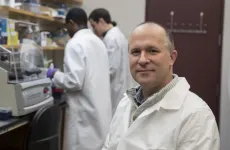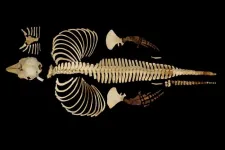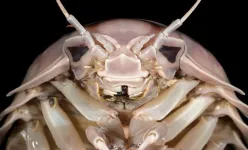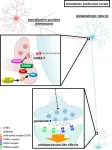(Press-News.org)
With antibiotic resistance a growing problem, University of Virginia School of Medicine researchers have developed cutting-edge computer models that could give the disease-fighting drugs a laser-like precision to target only specific bacteria in specific parts of the body.
As it stands, antibiotics kill bacteria indiscriminately. Because the drugs are used so widely, increasing numbers of dangerous bugs are growing resistant, threatening one of modern medicine’s most important weapons against disease.
UVA’s new approach, on the other hand, would dramatically limit how often bacteria are exposed to antibiotics, reducing the chance they could become resistant to antibiotics. Further, the approach would represent a significant step forward for precision medicine, allowing doctors to better tailor treatments to individual patients’ needs. Instead of taking an antibiotic that kills bacteria regardless of whether helpful or harmful, patients could be given antibiotics that target specific bacteria causing a specific problem in a specific area of the body.
“Many biomedical challenges are incredibly complex, and computer models are emerging as a powerful tool for tackling such problems,” said researcher Jason Papin, PhD, of UVA’s Department of Biomedical Engineering. “We’re hopeful that these computer models of the molecular networks in bacteria will help us develop new strategies to treat infections.”
More Targeted Antibiotics
UVA’s new approach was made possible by a herculean effort by Papin, PhD student Emma Glass and their collaborators. Working with Andrew Warren, PhD, of UVA’s Biocomplexity Institute, the researchers in Papin’s lab developed sophisticated computer models of every human bacterial pathogen with sufficient genetic information available.
Glass then analyzed all those models and identified shared traits among the bacteria. This analysis yielded the discovery that bacteria in certain parts of the body, such as the stomach, tended to share metabolic properties. Basically, where they live shapes how they function.
“Using our computer models we found that the bacteria living in the stomach had unique properties,” Glass said. “These properties can be used to guide design of targeted antibiotics, which could hopefully one day slow the emergence of resistant infections.”
The shared similarities among the microbes in different locales could be the Achilles’ heel for harmful bacteria in our bodies. With further research, doctors may be able to target specific types of bacteria in specific areas, reducing the need for broad-spectrum antibiotics.
Putting their computer-modeling approach to the test, Papin and his team have already found that they could inhibit the growth of harmful stomach bugs in lab experiments. That’s a promising sign for the future potential of their computer-modeling approach.
“We still have much to do to test these ideas for other bacteria and types of infections,” Papin said. “but this work shows the incredible promise of data science and computer modeling for tackling some of the most important problems in biomedical research.”
Findings Published
The researchers have published their findings in the scientific journal PLOS Biology. The research team consisted of Glass, Lillian R. Dillard, Glynis L. Kolling, Warren and Papin. The scientists have no financial interest in the work.
The research was supported by the National Science Foundation, awards 1842490 and NRT-ROL 2021791; the National Institutes of Health, grants T32
GM145443, R01 AI154242 and R01 AT010253; and the NIH’s National Institute of General Medical Sciences, grant T32 GM136615.
UVA’s Department of Biomedical Engineering is a joint program of the School of Medicine and the School of Engineering and Applied Science.
To keep up with the latest medical research news from UVA, subscribe to the Making of Medicine blog at http://makingofmedicine.virginia.edu.
END
Cigarette smoking is widespread and deadly, yet our understanding of how cigarette smoke actually causes serious respiratory illnesses is incomplete, which has severely hampered the development of effective treatments. Today (TBC) Australian researchers reveal how multiple chemicals found in cigarette smoke and e-cigarettes alter the function of a key type of immune cell found in the lungs.
The study, published in the Journal of Experimental Medicine (JEM), suggests that these alterations make cigarette smokers, ...
Miami (January 14, 2025) – People with COPD experience more falls and related injuries requiring medical care when using common fall-risk increasing drugs, according to a new study. The study is published in the November 2024 issue of Chronic Obstructive Pulmonary Diseases: Journal of the COPD Foundation, a peer-reviewed, open-access journal.
Chronic obstructive pulmonary disease (COPD) is an inflammatory lung disease, comprising several conditions, including chronic bronchitis and emphysema. Symptoms include breathlessness, fatigue and chronic cough. The disease affects more than 30 million Americans and is the fourth leading ...
UNSW engineers have demonstrated a well-known quantum thought experiment in the real world. Their findings deliver a new and more robust way to perform quantum computations – and they have important implications for error correction, one of the biggest obstacles standing between them and a working quantum computer.
Quantum mechanics has puzzled scientists and philosophers for more than a century. One of the most famous quantum thought experiments is that of the “Schrödinger’s cat” – a cat whose life or death depends on the decay of a radioactive atom.
According to quantum mechanics, unless the atom is directly observed, ...
The vaquita, which means “little cow” in Spanish, is the world’s smallest porpoise and most endangered marine mammal. They also have the smallest range of any marine mammal; about 1,500 square miles within the northern Gulf of California. Since 1997, vaquitas have experienced a dramatic population loss from about 600 individuals to an estimate of less than 10 animals to date. At this current rate, vaquitas are expected to become extinct imminently.
The vaquita’s decline is caused by entanglement in illegal gillnets used to fish totoaba, an endangered species prized for its swim bladder. Despite a gillnet ban and conservation efforts, ...
Giant isopods of the genus Bathynomus, which can reach more than 30 cm in length, are known as bọ biển or “sea bugs” in Vietnam. For the first time, one such species was described from Vietnamese waters and named Bathynomus vaderi. The name “vaderi” is inspired by the appearance of its head, which closely resembles the distinctive and iconic helmet of Darth Vader, the most famous Sith Lord of Star Wars.
Bathynomus vaderi belongs to a group known as “supergiants,” reaching lengths of 32.5 cm and weighing over a kilogram. So far, this ...
Babies were weaned earlier in cities in the Roman Empire than in smaller and more rural communities, according to a study of ancient teeth. Urban weaning patterns more closely hewed to guidelines from ancient Roman physicians, mirroring contemporary patterns of adherence to medical experts in urban and rural communities.
Roman health authorities recommended breastfeeding babies for two years. Carlo Cocozza and colleagues were interested in how ancient Romans actually fed their babies in varying settlement types. Carbon and nitrogen isotope ratios in dentine from the first permanent molars record ...
VANCOUVER, Wash. – While many studies have looked at possible evolutionary links between men’s strength and sexual behavior, a Washington State University study included data on women with a surprising result. Women, as well as men, who had greater upper body strength tended to have more lifetime sexual partners compared to their peers.
The study, published in the journal Evolution and Human Behavior, was designed to test evolutionary theories for human sexual dimorphism—namely that in early human history there was likely a reproductive advantage selecting for men’s greater upper body strength.
Another ...
New research1 underscores the potential role of pork consumption in supporting dietary and muscle health in Korean older adults. Older adults are a nutritionally vulnerable population who often face unique challenges, including meeting daily protein and micronutrient requirements.
The study,* conducted through a collaborative partnership between researchers from Gachon University in South Korea, Tufts University, Think Healthy Group, LLC, and other leading institutions, suggests that pork consumption may be positively linked to nutrient intake, diet quality and handgrip strength—an indicator of overall muscle strength in older adults.
Using data from more than 2,000 ...
The world is hurtling rapidly towards a developed future, and carbon fiber-reinforced polymers (CFRPs) play a key role in enabling technological and industrial progress. These composite materials are lightweight and highly strong, making them desirable for applications in various fields, including aviation, aerospace, automotive, wind power generation, and sports equipment.
However, recycling CFRPs presents a significant challenge, with waste management being a pressing issue. Conventional recycling methods ...
The global burden of anxiety- and depression-related disorders is on the rise. While multiple drugs have been developed to treat these conditions, current medications have several limitations, including slow action and adverse effects with long-term use. This underscores the urgent need for novel, rapidly-acting therapeutic agents with minimal side effects.
The delta opioid receptor (DOP) plays a key role in mood regulation, making it a promising target for therapeutic intervention. Studies have shown that selective DOP agonists (compounds that activate DOP), such as SNC80 ...








